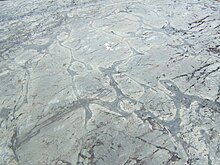משתמש:בנצי/ארגז חול 21: פרקמבריון
Overview
[עריכת קוד מקור | עריכה]Not much is known about the Precambrian, despite it making up roughly seven-eighths of the Earth's history, and what little is known has largely been discovered in the past 50 years. The Precambrian fossil record is poor, and those fossils present (e.g. stromatolites) are of limited biostratigraphic use.[1] This is because many Precambrian rocks are heavily metamorphosed, obscuring their origins, while others have either been destroyed by erosion, or remain deeply buried beneath Phanerozoic strata.[1][2]
It is thought that the Earth itself coalesced from material in orbit around the Sun roughly 4500 Ma (4.5 Ga) and may have been struck by a very large (Mars-sized) planetesimal shortly after it formed, splitting off material that came together to form the Moon (see Giant impact theory). A stable crust was apparently in place by 4400 Ma, since zircon crystals from Western Australia have been dated at 4404 Ma.[3]
The term Precambrian is somewhat out-moded, but is still in common use among geologists and paleontologists. It was briefly also called the Cryptozoic eon.
חיים לפני קמבריון
[עריכת קוד מקור | עריכה]אין יודעים מתי חיים צצו בכדור-הארץ, אבל פחמן שנתגלה בסלעים קדומים בני 3.8 מיליארד שנים הנמצאים באיים הסמוכים לחופו המערבי של גרינלנד, עשויים להיות ממוצא אורגני. חיידקים שהשתמרו היטב, ואשר גילם נאמד ??-3.46 מיליארד שנה, התגלו במערב אוסטרליה[4]. באזור זה נתגלו מה שמזוהים כמאובנים כנראה, קדומים יותר בכ-100 מיליון שנה. בחלקה המאוחר יותר של תקופת הקמבריון, נתגלו ממצאים חיידקיים מוצקים למדי.
מלבד דיווחים (?) ??? של צורות קדומות בהרבה מארה"ב ומהודו, נראה שצורות החיים הרב-תאית המורכבות הראשונות הופיעו על פני כדור-הארץ בערך לפני 600 מיליון שנה.
Life before the Cambrian
[עריכת קוד מקור | עריכה]תבנית:Geological eon תבנית:Details
Excepting a few contested reports of much older forms from USA and India, the first complex multicelled life forms seem to have appeared roughly 600 Ma. A quite diverse collection of soft-bodied forms is known from a variety of locations worldwide between 542 and 600 Ma. These are referred to as Ediacaran or Vendian biota. Hard-shelled creatures appeared toward the end of that timespan. The oldest fossil evidence of complex life comes from the Lantian formation, at least 580 million years ago.
A very diverse collection of life forms appeared around 544 Ma, starting in the latest Precambrian with a poorly understood small shelly fauna and ending in the very early Cambrian with a very diverse, and quite modern Burgess fauna, the rapid radiation of forms called the Cambrian explosion of life.
Planetary environment and the oxygen catastrophe
[עריכת קוד מקור | עריכה]
Details of plate motions and other tectonic functions are only hazily known in the Precambrian. It is generally believed that small proto-continents existed prior to 3000 Ma, and that most of the Earth's landmasses collected into a single supercontinent around 1000 Ma. The supercontinent, known as Rodinia, broke up around 600 Ma. A number of glacial periods have been identified going as far back as the Huronian epoch, roughly 2200 Ma. The best studied[דרוש מקור] is the Sturtian-Varangian glaciation, around 600 Ma, which may have brought glacial conditions all the way to the equator, resulting in a "Snowball Earth".
The atmosphere of the early Earth is poorly known, but it is thought to have been smothered in reducing gases, containing very little free oxygen. The oxygen-free early atmosphere has been disputed with evidence supporting an oxygenic atmosphere since the early Archean.[5]
When evolving life forms developed photosynthesis, molecular oxygen began to be produced in large quantities, causing an ecological crisis sometimes called the oxygen catastrophe. The oxygen was immediately tied up in chemical reactions, primarily with iron, until the supply of oxidizable surfaces ran out. After that the modern high-oxygen atmosphere developed. Older rocks contain massive banded iron formations that were apparently laid down as iron and oxygen first combined.
- ^ 1 2 James Monroe and Reed Wicander, The Changing Earth, 2nd ed, (Belmont: Wadsworth Publishing Company, 1997), p. 492.
- ^ "Pamela J.W. Gore, "The Precambrian". Retrieved on 10/05/11".
- ^ Zircons are Forever "Zircons are Forever". נבדק ב-2007-04-28.
{{cite web}}: Check|url=value (עזרה) - ^ Brun, Yves and Lawrence J. Shimkets, Prokaryotic development, ASM Press, Jan. 2000, p. 114 ISBN 978-1555811587
- ^ Clemmey, Harry; Badham, Nick (1982). "Oxygen in the Precambrian Atmosphere". Geology. 10 (3): 141–146. doi:10.1130/0091-7613(1982)10<141:OITPAA>2.0.CO;2.
